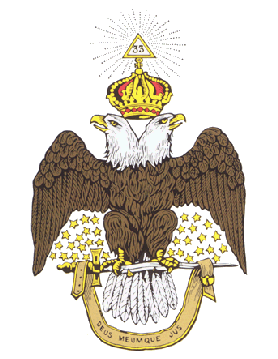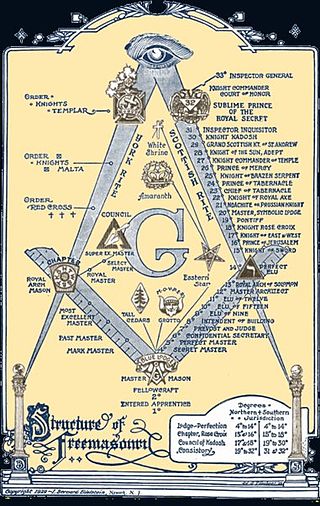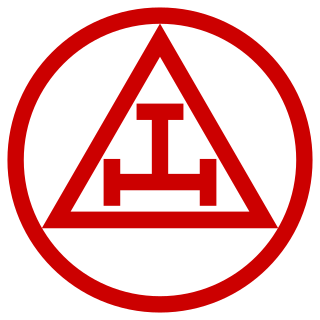Teachings
The Rite of Baldwyn considers the craft degrees, as worked by the United Grand Lodge of England, to compose the first degree, and that the Bristol workings are the oldest in England. The Holy Royal Arch is considered to compose the second degree. The Royal Arch degree as worked in Bristol for the Baldwyn Rite is the only one in England to employ the ceremony of 'Passing the Veils'. This was historically employed throughout England and is still commonly found in many other jurisdictions. The Baldwyn Encampment works the IIIº to Vº under its own sovereign powers, and these degrees are peculiar to it alone. After the Vº, the candidate takes the Knight Templar and Knight of Malta degrees in a Baldwyn Preceptory which is under warrant from the Great Priory of England. They constitute the VIº of the Rite. The final degree, that of VIIº, is the Knight of the Rose Croix of Mount Carmel, which is worked in Bristol under warrant from the Supreme Council 33°. After the VIIº, the candidate is, in effect, a full member of the Baldwyn Rite. [2]

The Ancient and Accepted Scottish Rite of Freemasonry is a rite within the broader context of Freemasonry. It is the most widely practiced Rite in the world. In some parts of the world, and in the Droit Humain, it is a concordant body and oversees all degrees from the 1st to 33rd degrees, while in other areas, a Supreme Council oversees the 4th to 33rd degrees.
In Anglo-American Freemasonry, York Rite, sometimes referred to as the American Rite, is one of several Rites of Freemasonry. It is named after York, in Yorkshire, England; where the legend of the Rite, was first practiced.
The Ancient and Primitive Rite, also called the Order of the Ancient and Primitive Rite of Memphis-Mizraim, is a Masonic Rite first popularized by John Yarker. It has been considered irregular by Masonic organisations such as the United Grand Lodge of England since at least 1860.

The Royal Order of Scotland is an appendant order within the structures of Freemasonry. Membership is an honour extended to Freemasons by invitation. The Grand Lodge of the Royal Order of Scotland is headquartered in Edinburgh, with a total of 88 subordinate Provincial Grand Lodges; of these, the greatest concentration is in the British Isles, with the rest located in countries around the world.

The Knights Templar, full name The United Religious, Military and Masonic Orders of the Temple and of St John of Jerusalem, Palestine, Rhodes and Malta, is a fraternal order affiliated with Freemasonry. Unlike the initial degrees conferred in a regular Masonic Lodge, which only require a belief in a Supreme Being regardless of religious affiliation, the Knights Templar is one of several additional Masonic Orders in which membership is open only to Freemasons who profess a belief in Christianity. One of the obligations entrants to the order are required to declare is to protect and defend the Christian faith. The word "United" in its full title indicates that more than one historical tradition and more than one actual order are jointly controlled within this system. The individual orders 'united' within this system are principally the Knights of the Temple, the Knights of Malta, the Knights of St Paul, and only within the York Rite, the Knights of the Red Cross.
Freemasonry in Sweden was introduced by the Swedish Order of Freemasons, founded in 1735 as the oldest still active Swedish fraternal order, working the Swedish Rite of Freemasonry. It is under royal patronage of the King of Sweden and closely associated with the Lutheran Church of Sweden. It is a jurisdiction that admits Christian men only, and is recognised by the United Grand Lodge of England as a Regular Masonic jurisdiction. Its total membership is about 16,500.

There are many organisations and orders which form part of the widespread fraternity of Freemasonry, each having its own structure and terminology. Collectively these may be referred to as Masonic bodies, Masonic orders, Concordant bodies or appendant bodies of Freemasonry.

There are Masonic degrees named after the Knights Templar but not all Knights Templar Orders are Masonic.

The Norwegian Order of Freemasons is the Masonic Grand Lodge in Norway. The first lodge was opened in 1749 and is still working. The Grand Lodge has followed the Swedish Rite since 1818, which requires its members to adhere to Christianity. During the union of Sweden-Norway, the Swedish-Norwegian king was Grand Master of the Order. The sovereign Grand Lodge of Norway was consecrated in 1891. As of 2009, the Order has about 20,000 members.
The Knight Kadosh is a Freemasonic degree or ceremony of initiation performed by a number of Supreme Councils of the Ancient and Accepted Scottish Rite of Freemasonry. It is the 30th Degree of the Southern Jurisdiction of the Scottish Rite for the United States of America, and the Ancient and Accepted Scottish Rite of Freemasonry of Canada. The Northern Masonic Jurisdiction of the Scottish Rite, does not currently confer a degree with the name Knight Kadosh. Instead its thirtieth degree is entitled "Grand Inspector."
Freemasonry in Denmark was first established in 1743 and is today represented by a number of Grand Lodges. The oldest and biggest Masonic Grand Lodge in Denmark is the Danish Order of Freemasons, in English also known as the Grand Lodge of Denmark.

The Royal Arch is a degree of Freemasonry. The Royal Arch is present in all main masonic systems, though in some it is worked as part of Craft ('mainstream') Freemasonry, and in others in an appendant ('additional') order. Royal Arch Masons meet as a Chapter; in the Supreme Order of the Royal Arch as practised in the British Isles, much of Europe and the Commonwealth, Chapters confer the single degree of Royal Arch Mason.

Royal Arch Masonry is the first part of the American York Rite system of Masonic degrees. Royal Arch Masons meet as a Chapter, and the Royal Arch Chapter confers four degrees: Mark Master Mason, Past Master, Most Excellent Master, and Royal Arch Mason.
The history of Freemasonry in Mexico can be traced to at least 1806 when the first Masonic lodge was formally established in the nation.

Thomas Dunckerley was a prominent freemason, being appointed Provincial Grand Master of several provinces, promoting Royal Arch masonry, introducing Mark Masonry to England, and instituting a national body for Templar masonry. This was made possible by an annuity of £100, rising to £800, which he obtained from King George III by claiming to be his father's illegitimate half brother.

The Order of Knight Masons is a chivalric Masonic order, open to all Master Masons who are also members of a Mark Lodge and a Royal Arch Chapter. Members of the order meet in Councils of Knight Masons which are governed by the Grand Council of Knight Masons based in Dublin, Ireland. A member of the group is a Knight Mason.
Freemasonry in Scotland in lodges chartered by the Grand Lodge of Scotland comprises the Scottish Masonic Constitution as regular Masonic jurisdiction for the majority of freemasons in Scotland. There are also lodges operating under the Scottish Masonic Constitution in countries outside of Scotland. Many of these are countries linked to Scotland and the United Kingdom through the Commonwealth of Nations and prior colonies and other settlements of the British Empire although there are several lodges in countries such as Lebanon, Belgium, Chile and Peru, which do not have such connections.

In Freemasonry, the first three Masonic degrees constitute the fundamental degrees in all Rites they are called Blue Lodge of Craft degree.










